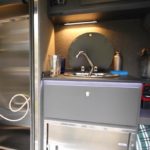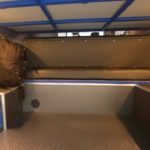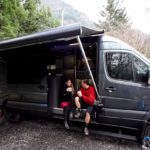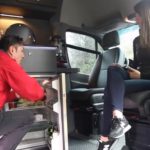
If you want to dye your hair red, then opting for henna is the most sensible course of action. In contrast to other products available on the market today, henna gives a result that is more permanent. However, the process does not come easy. Here are the following things you need to do when you want to dye your hair red successfully with henna.
You need to prepare 100-500 grams of henna, a medium-sized bowl, a spoon, plastic wrap, and lemon juice. Mix your henna and wait for twelve hours before you can use it. Put it in a dark area. However, you can use it for two hours if you will put in a warmer area. You should be cautious, though, to assure that it is not too hot.
Get your two bags of henna ready and pour it into the bowl. Add ¼ and ½ of a 16oz of lemon juice. You can substitute it with grape juice or orange juice if you have sensitive skin or add the juice with water. Then, you will just have to cover the bowl with plastic wrap and wait for twelve hours.
Now, here comes the process of applying henna onto your hair. Wear your gloves and start dividing your hair into sections. Unwrap your henna and add more lemon juice. Mix it until it will look like yogurt. Start applying your henna on the thick sections of your hair. Henna will make your hair tangled when you apply it on areas you are not yet ready to touch. Wrap your head with plastic wrap and start removing your gloves once you’re done. You can opt to leave the henna on your hair for three to four hours for best result.
In washing the henna out of your hair make sure to use gloves. It would be better if you will just put your head under the faucet when washing. After which, you need to shampoo your hair. You can also use lavender to rinse your hair once you are done washing it. This is if you do not want to smell like henna.
Henna is safe to use regardless of the type and texture of your hair. However, keep in mind that the result may vary from one person to another. Nonetheless, what your hair looks like before applying henna can be a factor on the shade of red that you may get. Overall, henna gives you a very permanent hair color.
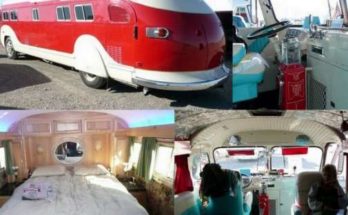
This little number made it to the Quartzsite RV show a while ago and caught the attention of a few people.
So, the origins of this red and white smooth-lined balloon?
It was manufacturers in 1946 in Loudnville, Ohio as a public transportation bus. The model is called a “Flxible” [sic]. During its transportation working days, it brought Americans and others all around the country long distance. One of the notable features of the design was a possible lack of headroom.
When people convert Flxibles, they often lower the floor. That’s so they can get around inside a lot more comfortably.
The decor is that of a late-40’s — early 50’s diner, and it has a jukebox beside an authentic dining room table, black and white tiled floor, and art-deco ornamentation.
These custom camper vans bring easy living to the great outdoors
For those who would rather camp off the grid…
Combining city vehicle and country camping, these camper vans are really adaptable. I guess all vans are adaptable, depending on what you put in them. The option many people look at is price, which is based a lot on how new of a camper van they buy, as well as features — do you want to go full-on camper or just some couches that fold into beds and maybe a cookstove?
This particular one is an offroad 4X4 new-style Sprinter van. There’s a whole scene of people who live in and customize Sprinters, which have been found to be one of the better designs for off-grid, travel, or camp-style living.
From the manufacturer: “Our latest 4×4 Outside Van creation compels you to do more, by allowing full access to conversion treats. Whether it be an extended overland adventure or a day trip to your favorite trail head; This stunning Graphic Grey Metallic 4×4 170 Mercedes Benz Sprinter will allow no compromise. Highlighted features include – Webasto heating and water system, Stage 3 Magnum battery power, duel micro galleys w/drop down sink and induction stove top, OSV stainless shower enclosure, OSV 3 panel bed, custom leather rollover bench, Isotherm refrigerator, Solar charger, paint match awning, OSV rear step bumper, retractable running boards (driver and passenger sides) and high-output LED driving lights.”
For options as far as cost and features, Outside Van offers vans with what it calls “core,” “configurable,” and “custom” conversions, none of which come cheap. A core van conversion generally takes 4-7 weeks to build, costing buyers between $48,000 to $53,000, which doesn’t even include the original price of the van. The more deluxe versions with heat and power, which takes months for them to complete, puts the price at around 80-135K total.
These Truck Drawers Make the Most of Your Space
This is awesome. period. Put anything you want on top. Keep everything inside secure.
I saw one of these for the first time a while ago. Since I’ve seen people put raised beds in their pickups in order to get enough width to put ATVs on top, which leaves some space underneath, I notices them, because these could fill the space under a flat bed.
There’s a couple of options here. One is to buy one for your pickup or even other type of vehicle (pictures below). The other is to make one, DIY style (there’s a picture of that, too).
From the manufacturer: “The normal TruckVault product adds a secure storage solution to virtually make and model of vehicle available. With the whole unit concealed beneath its carpeted surface, there’s nothing to catch the attention of wandering eyeballs. Within the unit’s interior, sensitive equipment and firearms are protected within a locked environment that does not promote either condensation or heat damage. Choose between Standard or Magnum heights and configure drawers to meet your needs.”
“TruckVault has a solution for every secure in-vehicle storage need whether it be for a Pick-up, SUV, Sedan, Van or any other vehicle on the road today. In addition to our vast array of stock designs, we also work meticulously with you on your custom needs. Our team of highly skilled Territory Representatives will walk you through every step of the process to ensure you get the product you need to tackle your tasks. We take great pride in our products and the quality they represent. Thanks for taking a look.” Contact a TruckVault sales representative for more information: (800) 967-8107.
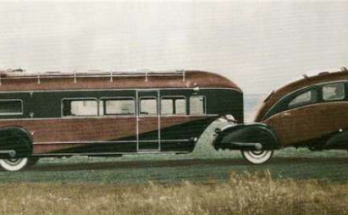
Vintage car lovers, unite! There’s this 1941 For Western Flyer that is up for grabs online! It is an original Western Flyer that was originally designed by none other than Clifford Brooks Stevens. However, this specific model was redesigned, restored, and personalized by Howdy Ledbetter.
If you are a vintage car collector, it’s impossible not to know Brooks Stevens. He lived from 1911 to 1995 and was considered one of the most notable and popular industrial designers of his generation. He was one of the founders of Designers Society of America and formed his own company in 1934 in Milwaukee.
Stevens is known for designing the Zephyr Land Yacht for the famous Bill Plankinton. The latter absolutely loved his tractor and trailer, which he demanded to be beautiful and, at the same time, comfortable. The brilliant industrial designer made the tractor and trailer complete with kitchen facilities, shower and radio equipment.
Eventually, when folks from the Western Printing Company saw Plankinton’s Land Yacht, he ordered Stevens to design a mobile showroom for his business. For this, Stevens designed what is now known as the “Western Clipper.” Imagine this mobile showroom, complete with a parking facility under 20 feet!
Brooks Stevens, since then, has been known for creating different designs of the original clipper. He even made one for Johnson’s Wax which was used during the 1940 New York World Fair. This clipper was complete with huge spaces for bunks. Shower bath and kitchen inside were equipped with running water. It has been called “Housecar” since then.
Among the other vehicles which he designed that proved his brilliance and excellence were the Skytop Hiawatha trains in 1948, the Oscar Mayer ‘Wienermobile.’ All of these are recorded and well-documented in different American museums. If you are a vintage car lover, you can find some posts online selling different Stevens designs. You might want to read first on his other creations through vintage car blogs or by visiting car museums across the globe.
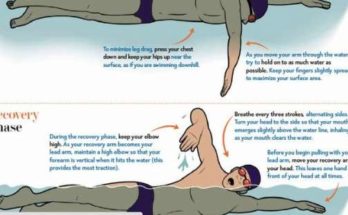
There are different swimming styles and strokes like breaststroke. This is the most popular swim stroke of all, where both arms execute half-circular movements at the same time under the water. The backstroke is faster than breaststroke but slower than butterfly and it is an excellent workout for the back. There is the butterfly stroke which is a very unique technique since it is performed with the face down in the water and the legs perform a dolphin kick while the arms move in a forward circle at the same time. Sidestroke is not used in swimming competitions. These are some techniques and strokes in swimming just to name a free, but the most useful swim stroke is the free style. It is the fastest and most efficient of the competitive swimming strokes. That is the reason why it is always used in swimming competitions.
Here are the winning steps and tips of free style stroke according to one study:
1. Position your body parallel to the bottom of the pool. You’ll be turning your arms and shoulders and twisting your body as you move your arms, but your head should remain centered until you need to breathe. This position will give you the balance you need to swim freestyle successfully.
2. Your elbow must come out of the water as this will prepare you to move the arm forward as far as you can. The arm that is not extended should hang at your side at the water, about perpendicular to the bottom of the pool, as you extend it backward.
3. Extend the arm as far as you can to maximize your speed and the distance you cover in the pool. Keep your fingers together to make a slight “cup” with your hand. Your other hand should rotate backward until it is parallel with your side.
4. To finish the stroke with the first arm, you’ll need to do the “catch,” which means you should curve your hand back inward toward your belly button, then out again by your hip as your hand “pulls” on the water and exits it. This will help you maximize your control over the water, which will help propel you forward. If you just move your arm back in a straight line, you won’t be able to “catch” the water as well. Then, fully extend your arm behind you so that your thumbs graze the side of your thighs below your suit-line.
5. Breathe every third stroke. Stroke with your right arm, your left arm, and then breathe when you stroke with your right arm again; then, stroke with your left arm, your right arm, and then breathe when you stroke with your left arm again. As you come up to breathe, place your ear on one shoulder with your cheek in the water, giving your mouth enough room to breathe comfortably.
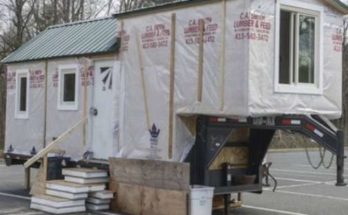
College senior Sarah Hastings is building a DIY fifth wheel in an attempt to get two birds with one project: have her own home, and have financial freedom.
Hastings is a senior at Mount Holyoke College where she studies architecture as her major. She desinged the tiny house on wheels in her sophomore year. It was a timber-frame design.
She’s building it now behind a garage at the school. Mobile tiny houses are often built on 8 foot wide trailers about 20 feet long. Hasting’s design is larger. It’s 200 square feet.
It sits on a 5th wheel trailer with a gooseneck hitch, which has safety advantages over a bumper hitch.
Hastings hasn’t yet decided on a vehicle to move her project around. She said she was looking for some land around Amherst and the surrounding area where she might reside.
These custom camper vans bring easy living to the great outdoors
For those who would rather camp off the grid…
Combining city vehicle and country camping, these camper vans are really adaptable. I guess all vans are adaptable, depending on what you put in them. The option many people look at is price, which is based a lot on how new of a camper van they buy, as well as features — do you want to go full-on camper or just some couches that fold into beds and maybe a cookstove?
This particular one is an offroad 4X4 new-style Sprinter van. There’s a whole scene of people who live in and customize Sprinters, which have been found to be one of the better designs for off-grid, travel, or camp-style living.
From the manufacturer: “Our latest 4×4 Outside Van creation compels you to do more, by allowing full access to conversion treats. Whether it be an extended overland adventure or a day trip to your favorite trail head; This stunning Graphic Grey Metallic 4×4 170 Mercedes Benz Sprinter will allow no compromise. Highlighted features include – Webasto heating and water system, Stage 3 Magnum battery power, duel micro galleys w/drop down sink and induction stove top, OSV stainless shower enclosure, OSV 3 panel bed, custom leather rollover bench, Isotherm refrigerator, Solar charger, paint match awning, OSV rear step bumper, retractable running boards (driver and passenger sides) and high-output LED driving lights.”
For options as far as cost and features, Outside Van offers vans with what it calls “core,” “configurable,” and “custom” conversions, none of which come cheap. A core van conversion generally takes 4-7 weeks to build, costing buyers between $48,000 to $53,000, which doesn’t even include the original price of the van. The more deluxe versions with heat and power, which takes months for them to complete, puts the price at around 80-135K total.
These Truck Drawers Make the Most of Your Space
This is awesome. period. Put anything you want on top. Keep everything inside secure.
I saw one of these for the first time a while ago. Since I’ve seen people put raised beds in their pickups in order to get enough width to put ATVs on top, which leaves some space underneath, I notices them, because these could fill the space under a flat bed.
There’s a couple of options here. One is to buy one for your pickup or even other type of vehicle (pictures below). The other is to make one, DIY style (there’s a picture of that, too).
From the manufacturer: “The normal TruckVault product adds a secure storage solution to virtually make and model of vehicle available. With the whole unit concealed beneath its carpeted surface, there’s nothing to catch the attention of wandering eyeballs. Within the unit’s interior, sensitive equipment and firearms are protected within a locked environment that does not promote either condensation or heat damage. Choose between Standard or Magnum heights and configure drawers to meet your needs.”
“TruckVault has a solution for every secure in-vehicle storage need whether it be for a Pick-up, SUV, Sedan, Van or any other vehicle on the road today. In addition to our vast array of stock designs, we also work meticulously with you on your custom needs. Our team of highly skilled Territory Representatives will walk you through every step of the process to ensure you get the product you need to tackle your tasks. We take great pride in our products and the quality they represent. Thanks for taking a look.” Contact a TruckVault sales representative for more information: (800) 967-8107.
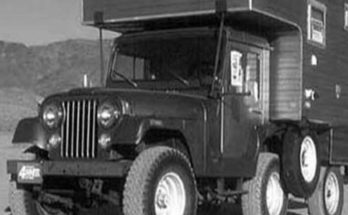
If you are tired of the hustle and bustle of the city and love the outdoors, and you’re also a collector on the side, the CJ5 Jeep Camper is for you. This camper was built by Ward Manufacturing’s division, Honorbuilt. It is estimated that there were only 336 produced. Its production ceased in the early 1970’s, when American Motor Company bought Keiser Jeep, and thus became one of the most sought after campers for collectors. It was one of the Jeep Campers introduced to the market and a lot of outdoors men got excited with its features.
One of the things that made this camper stood out among other is that it had its own axle and brakes, taking off some of the weight from the jeep; also a large pin can be latched and unlatched to secure the camper from the jeep. The bed is extended to fit snugly over the front seat of the jeep, maximizing every space of the camper and it also has a built in jack, so you can secure the camper and drive away on some exploration, hunting, fishing or simply some errand. This detaching system was a revolution, as this was the first of its kind during that period.
The interior of the camper is self contained and designed with comfort in mind; even with its tiny space many amenities are built in. Its look can be deceiving as it can sleep four people, two in the bunk overhead and the other two in a makeshift bed. Many of the amenities being offered by modern campers today such as water tanks, a stove, oven, toilet, gas, electric and heat were already offered by the CJ5 camper. Its kitchen has built in cabinets, stainless steel sink and running water thus cleaning the area can be made very easy.
The CJ5 Jeep Camper paved the way to the modern RV of today, and despite its short-lived status, it has made its mark and gave campers more options and the flexibility they were looking for. If ever luck finds your way and you get to see a CJ5 camper, bear in mind that its rarity also contributed to the modernization of the camping world.
 " >
" >



